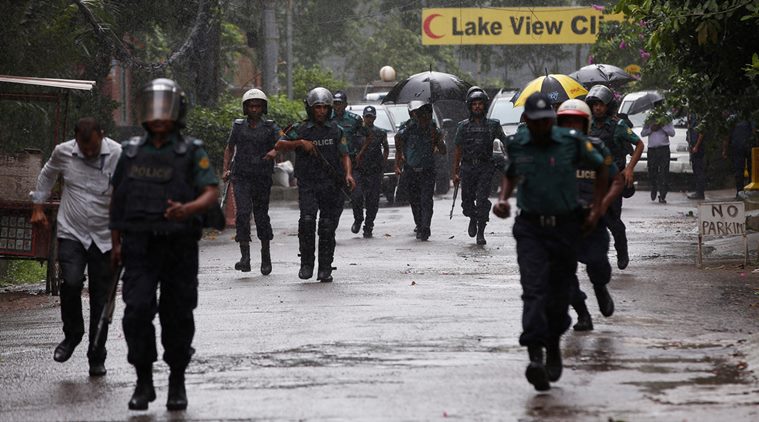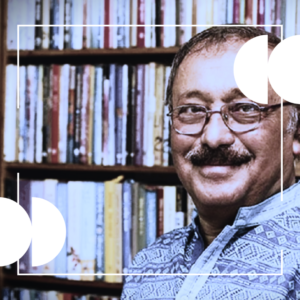
Policemen patrol on the road leading to the Holey Artisan Bakery and the O'Kitchen Restaurant after gunmen attacked, in Dhaka, Bangladesh, July 3, 2016. REUTERS/Adnan Abidi
On the anniversary of the audacious terrorist attack on the Holey Artisan Bakery, Bangladeshis may ask two questions: “Are we safer today than we were a year before?” and “Where do we go from here?” The answer to the second question is contingent on the answer to the first in the sense that it is the current situation which will determine the way forward. Addressing these questions requires examination of the actions of the government and their implications on the one hand, while assessment of the impacts of regional and global events germane to the militancy in Bangladesh, on the other. It is erroneous to believe that national boundaries are impervious to terrorism.
The absence of any major terrorist attack in the past year in the country may provide an impression that even if militancy is not completely defeated, militant organisations have been severely weakened and no longer pose a clear and present danger. Compared to the strings of attacks between early 2015 and July 2016, relative calm in the past year may breed this complacency. However, security operations conducted on an almost daily basis are testimonies to the presence of resilient militant organisations and their success in recruiting new members. Indeed, media reports do not draw attention of the citizens as much as they did in previous years. This should not be interpreted as people’s confidence that the danger of militancy has diminished; instead it tells that people have on the one hand accepted this as the ‘new normal’, while on the other hand are not entirely buying into the official narratives.
In the past year, security forces conducted 17 major operations in ‘militant dens’ which resulted in the deaths of 59 suspected militants including five women and six children. Some were killed by security forces while others had blown themselves up instead of surrendering during these operations. The spread of these operations reveals that the militant groups are not located in pockets, but instead exist in various parts of the country. Unfortunately, not all security operations have remained above controversies; the Narsingdi operation in May is a case in point. While we need to acknowledge that information about potential threats cannot be one hundred percent certain all the time, it’s also true that incidents like these raise misgivings among people. Besides, claims by family members of arrested suspected militants that they were picked by law enforcing agencies long before they were produced before the press and courts are not helpful by any measure.
After the Holey Artisan attack, a consensus seems to have emerged that involving the community and building a social movement is a sine qua non for confronting the scourge of militancy. But regrettably, to date, no concrete steps have been taken to involve citizens of all political persuasions. Sporadic events, such as staging human chains in cities and discussion events at various educational institutions, were all that followed. Government efforts since then have almost exclusively focused on the security operations; in other words, the government seems to have opted for using force as the only way to combat the growing menace.
While carrying out raids, killings and apprehending the suspected militants have become the primary methods, legal loopholes and protracted legal processes are allowing suspected militants to secure bail from the courts. A recent press report documented that 148 suspected militants were granted bail in the past six months. Of course, one cannot be denied due process, but officials of the counter-terrorism unit confided to the press that there are neither effective mechanisms nor enough resources to monitor these suspected individuals after they are released. There are instances of recidivism. A comprehensive counter-terrorism strategy, which seems to be wanting, would have addressed this lacuna.
One of the key elements of an effective comprehensive counter-terrorism strategy is a counter-radicalisation programme. There are usually three components to a counter-radicalisation programme: deradicalisation, disengagement and radicalisation prevention. “Deradicalisation measures seek to lead an already radicalised individual to abandon his or her militant views. Disengagement entails a less dramatic shift whereby an individual abandons involvement in a terrorist group or activities while perhaps retaining a radical worldview. Radicalisation prevention measures seek to prevent the radicalisation process from taking hold in the first place and generally target a segment of society rather than a specific individual,” according to Lorenzo Vidino, Director of the Program on Extremism at George Washington University. The government’s anti-militancy initiatives and actions do not show any indications of counter-radicalisation programmes. Take for example the deradicalisation issue. There are reportedly 669 militants in various prisons of the country. Yet we haven’t heard of any programmes targeted at these inmates. Extensive literature in criminology suggests that prisons are ‘schools for crimes’; similar conclusions have been drawn while studying terrorists. American criminologist Harvey Kushner argued in Holy War on the Home Front that Western prisons are one of the main recruitment grounds for Al Qaeda. These inmates can become sources of radicalisation of other prisoners.
Notwithstanding the necessity to identify and discuss the misinterpretation of religious texts by the militants, that alone and ‘preaching to the choir’ about the history of syncretic tradition do little to dissuade vulnerable individuals. Prevention is meant to create a socio-political environment which rejects extremism and violence. Prevalence of extremist rhetoric in society and politics, naturalisation of violence as a political act, use of force as the principal mode of governance, the absence of the rule of law, impunity of segments of society, shrinking space for dissension, and an epidemic of corruption create an enabling environment within which the militant ideology thrives. As the last point is worth underscoring, a study by Transparency International (TI), has demonstrated that “corruption is the most powerful weapon in the armoury of violent extremism.” The drivers of militancy can be different for individuals, but without an enabling environment of marginalisation, militants won’t be able to find sympathetic ears. This is the terrain where the battle between the ideology of inclusiveness and ideology of hate is fought. This can only be ignored at one’s own peril. The answer to the question as to whether this is comprehended, let alone embraced, as a strategy in Bangladesh, is too obvious to be spelled out.
As I said earlier, the trajectory of militancy cannot be discerned without taking the regional and global landscapes into consideration. The sensitivity of the government and its die-hard supporters regarding any kind of external ties of the militants is baffling, to say the least. The government has strongly denied the existence of the ISIS in Bangladesh. Without relitigating the issue (I have discussed this at length well before the horrific café attack, see “Debate over Bangladeshi militants’ external connections”, The Daily Star, May 24, 2016), we can refer to a recent press report which has documented that of the 42 missing individuals, 33 have joined the ISIS in Syria and Iraq. Four of these have died either in US attacks or in the battle on behalf of ISIS (Prothom Alo, June 6, 2017). Three youths who appeared in the propaganda video of ISIS soon after the July 1 attack had left Bangladesh in previous months. The same is true with respect to joining Al Qaeda in Indian Subcontinent (AQIS). The AQIS, founded in 2014, has its foot soldiers in the country. The Central AQIS declared in April that its chief of the Bangladeshi branch, Sohel, died in a battle in Kandahar, Afghanistan. Another Bangladeshi, Saiful Islam Hasan, was reportedly killed in a US attack in 2015. The Straits Times of Singapore reported on June 1 that “since late 2015, some 40 Bangladeshi nationals in Singapore were found to have been radicalised, supporting the use of violence to pursue their extremist ideology. Several of them were planning to carry out armed violence against the government in Bangladesh.” Several Britons of Bangladeshi-origin have joined ISIS in the past. Recent developments in India are worrying too. The ISIS India branch, founded in late 2015, is ‘gaining momentum’ in recent months. Reports that a neighbouring country is identified as the source of explosives found in militant dens during recent operations and that the weapons used in the July 1 attack were ‘modified’ in that country cannot be ignored.
The global dimension of terrorism does not have any good news either. As the so-called capital of the ‘Caliphate’ of ISIS, Raqqa, is about to fall, foreign fighters are leaving the battlefield and returning to their respective homelands. ISIS leaders have called its sympathisers to engage in attacks wherever they are located. The increased number of attacks in Europe shows that the supporters are heeding the call. The five-week long battle between the ISIS affiliate Abu Sayyaf and the Philippine Army at Marawi is quite alarming. All these point to a shift in ISIS strategy and its desire to spread terror all around the globe.
The regional and international developments in recent months and the course of actions of the government in the country along with poor governance, fractious politics and the authoritarian bent of government do not paint a promising picture. The apparent success in taming the militants should neither mask the reality that they have remained resilient nor should they make anyone complacent. The way forward, particularly in the medium- and long-term, is to devise a comprehensive counter-terrorism strategy, engage in ideological battle instead of relying on force alone, and lessen the enabling environment.
Published in the Daily Star, 1 July 2017





